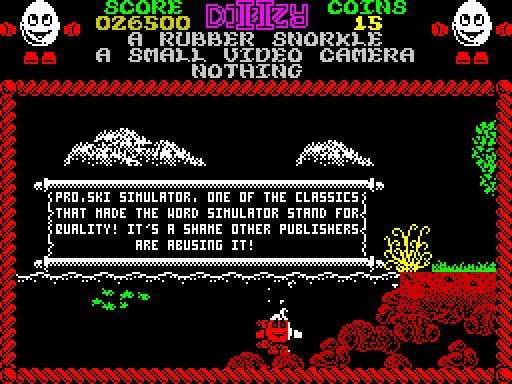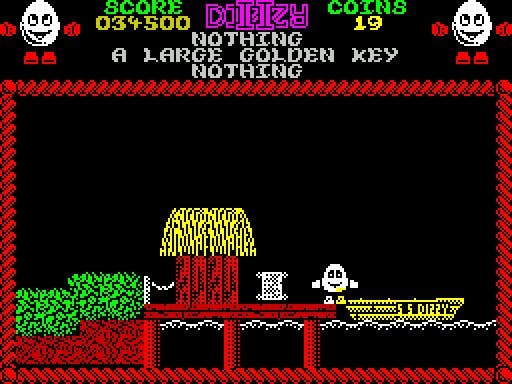Retrospective: Treasure Island Dizzy
I am the Eggman.
I can't quite remember whether Treasure Island Dizzy was the best Dizzy game or the worst. I'm sure it was one or the other.
Like most people, when I look back at old games I conveniently forget the flaws and recall just the good stuff. With Treasure Island Dizzy, the second game in the series released in 1989, I have very happy memories of exploring the tree house village and finding secret caves while tapping my foot to a fantastic in-game tune that was as chirpy and as full of life as Dizzy himself.
But no matter how hard I try, I can't overlook the awful inventory system which made it far too easy to discard items by mistake. Not a big deal maybe, until you accidentally dropped the rubber snorkel while you were underwater and died instantly as a result. And as you were only granted a single life it meant a profanity-peppered trip back to the start.

As the title suggests, there was lots of water in the game and I seemed destined to drown in it rather often. I vividly remember that, right at the end of the game, you had to jump onto the boat which ferried you to the final screen. However, the boat moved back and forth and I slightly mistimed the jump and Dizzy rolled slowly, helplessly into the water. There was rage. It was like running a marathon - okay, a 10k race - only to fall into an open manhole inches from the finish line.
Despite these failings, Treasure Island Dizzy is not the worst game in the series. It's definitely better than Dizzy's debut outing, which carried the burden of being self-dubbed "The Ultimate Cartoon Adventure". It was actually more of an arcade game where the emphasis was on negotiating platforms and dodging nasties. The follow-up focused on puzzle-solving, and was much better for it.
To escape from the island on which you were stranded you had to barter with a sinister-looking shopkeeper who coveted various valuables. These treasures were often hidden so you needed to solve a series of object-based puzzles to uncover them (fairly obvious stuff like using dynamite and a detonator to clear rocks in the gold mine and, er, using a glass sword to access a secret cave beneath a gravestone). Dizzy could carry up to three items, rather than just one in the original, which cut down on the amount of needless backtracking (although some toing and froing was still involved).

In return for the valuable items the baleful shopkeeper would give you a boat, an outboard motor (and petrol) to power it, and an ignition key to start it and make good your escape. The puzzles wouldn't stump seasoned adventurers, but there was a side quest that just might. Scattered around the island were 30 gold coins - some in plain view, some sneakily hidden - and to finish the game properly you had to collect every one of them. I eventually found all 30 - with a helping hand from the Playing Tips pages in Crash magazine, obviously.
Treasure Island Dizzy was quickly followed by Fantasy World Dizzy. The third game served up the same successful mix of exploration and puzzle solving, and added a touch more humour (mainly thanks to the introduction of Dizzy's family and friends, the Yolkfolk). Crucially, the game introduced a proper, working inventory system and Dizzy started the game with three lives, thereby instantly remedying the two chief problems with its predecessor. This is probably the fans' favourite entry, with some even declaring it as the BEST GAME EVER.
The next three games in the series weren't directly developed by series creators Philip and Andrew Oliver - and it showed. Magicland Dizzy and Spellbound Dizzy offered more of the same but made the mistake of featuring bigger worlds that weren't necessarily better (the latter was spread over 105 screens, where as Treasure Island Dizzy had just 44). The sixth game, Prince of the Yolkfolk, wisely shrank the size of the map and reduced the challenge. You could argue that it simplified things too much, as I remember completing the game over a couple of evenings - whereas I spent weeks on Spellbound Dizzy and never managed to finish the damn thing.

Two further sequels followed. Crystal Kingdom Dizzy was the first to be released as a full-price title, but it wasn't worth the extra money. More successful was Fantastic Dizzy, an adventure designed specifically for consoles and 16-bit computers that mixed together locations and situations from earlier games. It played like a Dizzy greatest hits package with updated graphics.
Of the eight Dizzy outings, there was some surprise when Codemasters recently announced that Prince of the Yolkfolk was the one it had chosen to revive on iOS and Android devices. Surely one of the earlier games would have been a more popular choice? Yet Yolkfolk is perhaps the ideal entry to test the water. It features many of the best Dizzy elements concentrated into a short but sweet cartoon adventure. Should it be successful (and that could largely depend on how well the controls are implemented), the more celebrated instalments will surely follow the same route.
In its original form, Treasure Island Dizzy is not the worst Dizzy game and it's not the best either. But it could be the best. If Codemasters was to address the flaws with the inventory system and provide players with more than one measly life then it would instantly become my favourite Dizzy adventure ever. The story and setting were never bettered and it was challenging without being overly difficult. For me and other fans, the possibility that we might one day be able to download a HD update of the game is hugely eggciting.
Oh come on! One thousand words and just one egg pun. Give me a break.

